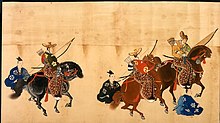| Revision as of 21:11, 23 January 2009 edit Enkyo2 (talk | contribs)Autopatrolled, Pending changes reviewers58,409 edits initial text of stub article -- 1st steps in a constructive directionNext edit → |
| (No difference) |
Revision as of 21:11, 23 January 2009
Main article: Horses in warfare
Horses in East Asian warfare are inextricably linked with the strategic and tactical evolution of armed conflict. The earliest evidence of horses ridden in warfare dates from Eurasia between 4000 and 3000 BC. As in most cultures, a war horse used as a riding animal was trained to be controlled with limited use of reins, responding primarily to the rider's legs and weight. Horses were significant factors in the Wu Hu attacks on China, and the Mongol conquest of much of Eurasia.
China
The Chinese horses were culled from the vast herds roaming free on the grassy plains of northeastern China and the Mongolian plateau. These hardy ponies were generally short-legged with barrel chests. Speed is not anticipated from this configuration, but strength and endurance are characteristic features.
The Chinese used chariots for horse-based warfare until light cavalry forces became common during the Warring States era (402-221 BC); and speedy cavalry accounted in part for the success of the Chi'in. A major proponent of the change to riding horses from chariots was Wu Ling, c.320 BC; however, conservative forces opposed change, which limited the growth of cavalry.
Japan
The Japanese samurai fought as cavalry for many centuries.

The samurai were particularly skilled in the art of using archery from horseback. The archery skills of mounted samurai were developed by training such as Yabusame, which originated in 530 AD and reached its peak under Minamoto Yoritomo (1147–1199 AD) in the Kamakura Period. They switched from an emphasis on mounted bowmen to mounted spearmen during the Sengoku period (1467–1615 AD).
Korea
The Korean horse is the smallest of the East Asian breeds, but it appears to be the strongest in terms of its size.
Burma
Burmese horses are somewhat smaller than the Chinese breed, but they are more adept at jumping.
Horses in logistical support
Traditionally, the horse is traditionally used as a pack animal, essential in providing logistical support for military forces.
Notes
- Equestrian Federation of Australia. "Dressage Explained". EFA Website. Equestrian Federation of Australia. Retrieved 2008-07-16.
- Goodrich, L. Carrington. (1959). A Short History of the Chinese People, pp. 83-84.
- Nicolle, Medieval Warfare Source Book: Christian Europe and its Neighbors, pp. 91-94.
- Gilbey, Walter. (1900). Small Horses in Warfare. p. 26.
- Goodrich, p. 99.
- Ellis, John. (2004). Cavalry: The History of Mounted Warfare, pp. 19-20.
- Turnbull, Stephen R. (2002). War in Japan 1467-1615, pp. 15-20.
- "The History of the Takeda school Kyuubadou". The Takeda School of Horseback Archery. Retrieved 2008-11-35.
{{cite web}}: Check date values in:|accessdate=(help) - Gilbey, p. 27.
- Gilbey, pp. 26-27.
References
- Ebrey, Patricia B., Anne Walthall and James B. Palais. (2005). Pre-Modern East Asia to 1800: A Cultural, Social, and Political History. Boston: Houghton Mifflin Company. 10-ISBN 0-618-13386-0; 13-ISBN 978-0-618-13386-4; OCLC 61367794
- Ellis, John. (2004). Cavalry: The History of Mounted Warfare. New York:Putnam. 10-ISBN 0-399-12179-X; 13-ISBN 978-0-399-12179-1; OCLC 4359157
- Gilbey, Walter. (1900). Small Horses in Warfare. London: Vinton. OCLC 1327766
- Goodrich, L. Carrington. (2007). A Short History of the Chinese People. Alcester, Warwickshire: Readcountrybooks.com. 10-ISBN 1-406-76976-2; 13-ISBN 978-1-406-76976-0
- Nicolle, David. (2000). Medieval Warfare Source Book: Warfare In Western Christendom. London : Arms and Armour. 10-ISBN 1-854-09196-4; 13-ISBN 978-1-8540-9196-3; OCLC 34203769
- Turnbull, Stephen. (2002). War in Japan: 1467–1615. Oxford: Osprey Publishing. 10-ISBN 1-841-76480-9; 13-ISBN 978-1-841-76480-1